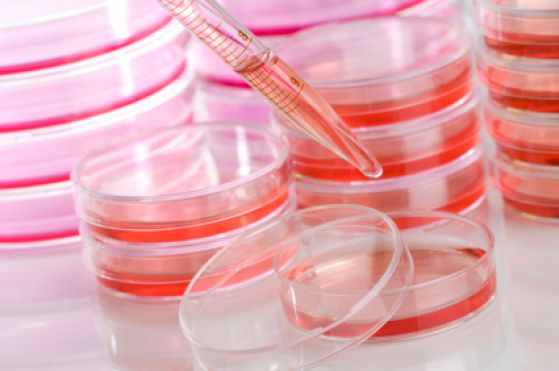Erythrocytes or red blood cells (RBCs) are the most abundant cell population comprising of ~45% of the total blood volume, whose main function is to deliver oxygen to the body tissues. Red blood cells lack a nucleus and most organelles to provide maximum space for hemoglobin – a complex metalloprotein containing heme groups whose iron atoms temporarily bind to oxygen molecules and release them throughout the body. Mammalian erythroid progenitors originate from a megakaryocyte-erythroid progenitor (MEP) and undergo the gradual process toward terminal differentiation. Two globin gene switches occur during development: the embryonic to fetal globin switch, which coincides with the transition from embryonic (yolk sac) to definitive (fetal liver) hematopoiesis; and fetal to adult switch, which occurs during the perinatal period. During erythroblast differentiation, the chromatin condenses while the hemoglobin concentration increases. Chromatin condensation involves histone deacetylation and unknown signals that activate the Rac-GTPases-mDia2 pathway, which is required for the formation of a contractile actin ring and subsequent enucleation, the process in which the nucleus is rapidly squeezed out of the cell. Erythroid precursors proliferate, differentiate, and enucleate within specialized niches called erythroblastic islands. These hematopoietic compartments are composed of erythroblasts surrounding a central macrophage. The central macrophage communicates with erythroblasts through a number of signaling molecules and phagocytizes their nuclei after enucleation.
In 1977, the American biochemist Eugene Goldwasser isolated the human protein erythropoietin (EPO), which supports the generation of mature blood cells. EPO became a blockbuster product that changed the lives of millions of patients suffering from hematological diseases. Although EPO with other specific additives allow red blood cells to mature in vitro without a supportive role of macrophages, the resulting proliferation and enucleation efficiency of red blood cells is lower than their capacities in vivo, suggesting the importance of a niche microenvironment. Blood transfusions are a common treatment for severe anemia and massive blood loss due to trauma. A type O-negative red blood cell can be transfused to patients of all blood types and is always in great demand. Thus, the derivation of (O)Rh-negative RBCs from PSCs could be an effective way to overcome shortages in donated red blood cells. Red blood cells can be produced from human pluripotent stem cells (hESCs and iPSCs) through various differentiation systems such as an embryoid body (EB) formation and coculturing hPSCs on top of stromal feeder cells.



In general, the existing methods are sufficient for a large-scale production of hPSC-derived red blood cells, whose in vitro expansion capacity is greater than the expansion potential of the bone marrow, peripheral blood, or even cord blood-derived erythroid progenitors. Despite the large amounts of RBCs were obtained in many studies, the majority of the resulting RBCs expresses embryonic ε– and fetal γ-globins with low levels of detectable adult β-globin. Although no differences were observed between hiPSC and hESC lines in terms of erythroid commitment and expression of erythroid markers, iPSC-derived red blood cells have lower proliferation activity and produce less enucleated cells.Robert Lanza’s group suggested the idea of developing an early hemato-endothelial progenitor, a hemangioblast, which can be expanded and cryopreserved. This study, published in Nature Methods in 2007, demonstrated the regenerative properties of blast cells that differentiate into multiple hematopoietic lineages as well as into endothelial cells. The extended coculture of these cells on OP9 feeders facilitated enucleation in up to 65% of cells and the expression of β-globin in up to 15% of the cells.
In 2010 a group of French scientists announced the complete differentiation of human induced pluripotent stem cells into definitive erythrocytes. Lapillonne and colleagues employed a feeder free, two-step differentiating system to produce mature blood cells from hESCs and iPSCs. In the first step, researchers initiated blood development by conditioning embryoid bodies in the presence of cytokines. To obtain mature erythrocytes, they further cultured cells in the presence of EPO, SCF, IL3 and 10% of human plasma for another 25 days. The resulting population contained up to 10% of enucleated cultured RBC from hiPSC, and 66% of enucleated cultured RBC from H1-hESC. The vast majority (~93%) of PSCs-derived red blood cells expressed the tetrameric form of fetal hemoglobin HbF (α2γ2). The CO-rebinding kinetics of hemoglobin from hESC- and hiPSC-derived erythroid cells was almost identical to those of cord blood suggesting that the HbF in these erythroid cells is functional.
Several studies have shown a time-dependent increase in β-globin expression, the oxygen dissociation curve and G6PD activities similar to normal RBCs. Nevertheless, significant progress is needed in the production of terminally differentiated /enucleated erythrocytes. Thus, at least two major steps are required for future therapeutic use of in vitro generated RBCs: (i) finding a cost-effective method for generating fully maturated, enucleated erythrocytes, and (ii) the evaluation of their biophysical parameters such as membrane surface potential, pliability, half-life in vivo, hemoglobin packing, gas exchange properties, and immunogenicity.